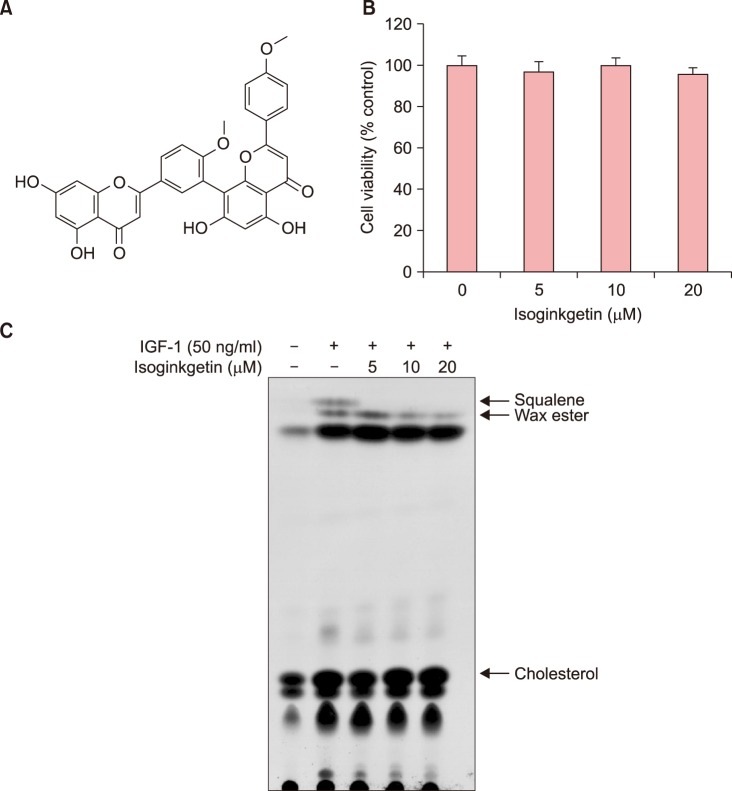Ann Dermatol.
2018 Jun;30(3):394-396. 10.5021/ad.2018.30.3.394.
Isoginkgetin Inhibits Insulin-Like Growth Factor-1-Induced Sebum Production in Cultured Human Sebocytes
- Affiliations
-
- 1Department of Dermatology, Chungnam National University School of Medicine, Daejeon, Korea. cdkimd@cnu.ac.kr
- 2GF-Herb Co., Nonsan, Korea.
- 3Picostech Co., Pyeongtaek, Korea.
- 4Skin Med Co., Daejeon, Korea.
- KMID: 2419196
- DOI: http://doi.org/10.5021/ad.2018.30.3.394
Abstract
- No abstract available.
Figure
Reference
-
1. Shi VY, Leo M, Hassoun L, Chahal DS, Maibach HI, Sivamani RK. Role of sebaceous glands in inflammatory dermatoses. J Am Acad Dermatol. 2015; 73:856–863. PMID: 26386632.
Article2. Chen W, Obermayer-Pietsch B, Hong JB, Melnik BC, Yamasaki O, Dessinioti C, et al. Acne-associated syndromes: models for better understanding of acne pathogenesis. J Eur Acad Dermatol Venereol. 2011; 25:637–646. PMID: 21198949.
Article3. Kim H, Moon SY, Sohn MY, Lee WJ. Insulin-like growth factor-1 increases the expression of inflammatory biomarkers and sebum production in cultured sebocytes. Ann Dermatol. 2017; 29:20–25. PMID: 28223742.
Article4. Krautheim A, Gollnick HP. Acne: topical treatment. Clin Dermatol. 2004; 22:398–407. PMID: 15556726.
Article5. Hwang YL, Im M, Lee MH, Roh SS, Choi BW, Kim SJ, et al. Inhibitory effect of imperatorin on insulin-like growth factor-1-induced sebum production in human sebocytes cultured in vitro. Life Sci. 2016; 144:49–53. PMID: 26631504.
Article6. Smith TM, Gilliland K, Clawson GA, Thiboutot D. IGF-1 induces SREBP-1 expression and lipogenesis in SEB-1 sebocytes via activation of the phosphoinositide 3-kinase/Akt pathway. J Invest Dermatol. 2008; 128:1286–1293. PMID: 17989724.
Article7. Trivedi NR, Cong Z, Nelson AM, Albert AJ, Rosamilia LL, Sivarajah S, et al. Peroxisome proliferator-activated receptors increase human sebum production. J Invest Dermatol. 2006; 126:2002–2009. PMID: 16675962.
Article8. Lee SJ, Choi JH, Son KH, Chang HW, Kang SS, Kim HP. Suppression of mouse lymphocyte proliferation in vitro by naturally-occurring biflavonoids. Life Sci. 1995; 57:551–558. PMID: 7623623.
Article9. O'Brien K, Matlin AJ, Lowell AM, Moore MJ. The biflavonoid isoginkgetin is a general inhibitor of Pre-mRNA splicing. J Biol Chem. 2008; 283:33147–33154. PMID: 18826947.
- Full Text Links
- Actions
-
Cited
- CITED
-
- Close
- Share
- Similar articles
-
- Insulin-Like Growth Factor-1 Increases the Expression of Inflammatory Biomarkers and Sebum Production in Cultured Sebocytes
- Inhibition of Insulin-Like Growth Factor-1–Induced Sebum Production by Bilobetin in Cultured Human Sebocytes
- Dieckol Inhibits the Effects of Particulate Matter 10 on Sebocytes, Outer Root Sheath Cells, and Cutibacterium Acnes−Pretreated Mice
- Azidothymidine Downregulates Insulin-Like Growth Factor-1 Induced Lipogenesis by Suppressing Mitochondrial Biogenesis and Mitophagy in Immortalized Human Sebocytes
- Effects of <10-μm Particulate Matter on Cultured Human Sebocytes and Outer Root Sheath Cells and Usefulness of Siegesbeckia Herba Extract



